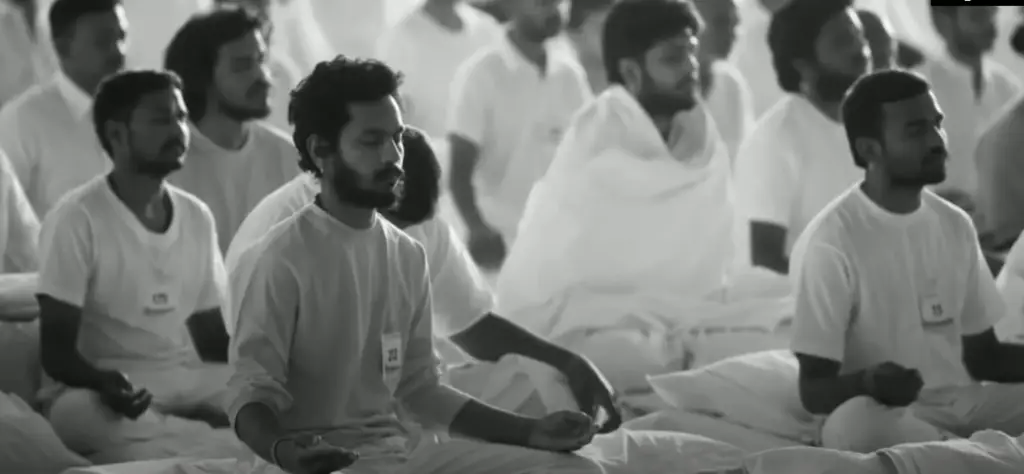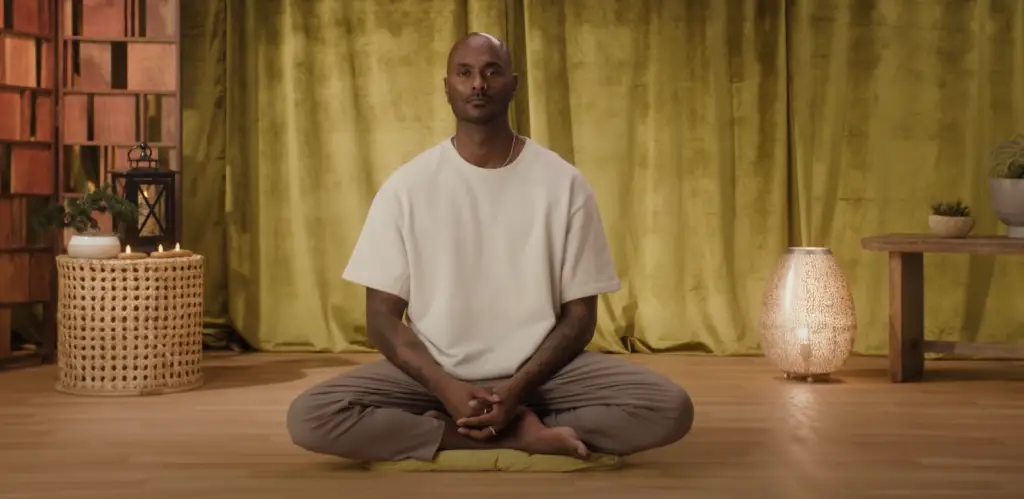Samyama is an ancient meditation technique that was described by Patanjali thousands of years ago. This meditation mainly concentrates on becoming one with an object of choice.
Practitioners do Samyama meditation mainly to increase their overall focus and to reduce negative thoughts. However, Samyama meditation offers more than that and can be used in various ways.
In this guide, we’ll be discussing the origin and purpose of Samyama meditation, how it can help you understand the universe, and how to make the most out of it.
So, let’s get right to it.

Samyama Meaning
The word ‘Samyama’ was introduced in the Ashtanga Yoga or eight-stage yoga by Patanjali. There are two parts to this word, Sam and Yama. Sam means integration or together, whereas Yama means discipline.
So, in the literal sense, Samyama refers to the combined practice of integration and discipline. Some yogis like Swami Sivananda define it as the “Perfect control of the mind.”
Understanding the Yoga Sutras is crucial to gaining a deeper comprehension of Samyama Meditation, as the Sutras provide the foundational principles and techniques that inform this powerful Samyama meditation practice.
Let’s give you a short overview
Yoga Sutras
There are eight Yoga sutras that are noted in the Indian scripture Yoga Sutras of Patanjali. Meditation practitioners hold this scripture close to heart because it’s one of the few books that offer extensive knowledge and information about meditation practices.
Out of the eight, Samyama meditation focuses on three only. These are Dharana, Dhyana, and Samadhi.
They are explained as follows
- Dharana
Dharana refers to focusing on an object.
- Dhyana
The Dhyana stage is the point is a meditation practice where the mind starts dissolving and the person stops his train of thought to complete silence.
- Samadhi
Samadhi is the next step from Dhyana, where the practitioner achieves masters his inner engineering and achieves complete stillness, often accompanied by pure bliss.
Like that, Samyama meditation techniques allow one to combine the last three limbs of yogic practices to attain absolute inner silence and focus.
How to Practice Samyama?

Before we get started into the practices of the mind, it’s important to make sure your asana practice is perfect. While performing Samyama meditation, it’s important you sit with a straight spine.
However, the spine has to be relaxed as well, so practice some relaxation techniques beforehand.
Other yoga postures are tucking your chin down, as this helps to lengthen your neck. You can use either use a mudra or you can simply put your hands on your lap.
There’s no strict rule about this, so you should follow whatever makes you feel comfortable and grounded. Next comes the first stage of entering the Samyama state.
Dharana Stage
In the first step of Samyama meditation, one has to focus on an outward object. Fixating on a single object allows one to control his flow of mind, thus allowing that person to dissolve every other thought in his mind.
The Dharana stage can be performed in different ways. But the best way would be to set a candle flame in front of the practitioner. The candle has to be placed a meter in front of the practitioner.
While you try to focus on the candlelight, you can try some breathing techniques to calm your body and mind even further. Practicing deep breaths can really help in these cases.
Another important mental exercise in this stage is you must let go of any thought that comes to your mind. Don’t dwell on the thoughts or fight them, rather let them flow through you without affecting you.
According to Patanjali, if one can maintain profound stillness for twelve seconds, it’s called Dharana or the first stage.
Dhyana Stage
The Dharana and Dhyana stages almost overlap in the sense that there isn’t any difference in practice. Rather, you’ll have to work on honing your focus even further.
In fact, making sure you maintain the Dharana stage without any interruption qualifies as the Dhyana stage.
Once you reach this stage, you’ll be free from any negative thoughts or external factors and truly achieve self-awareness and self-realization. Even in this stage, you can use external objects to maintain your focus.
Patanjali stated that if one manages to keep the mind free of thoughts for 144 seconds, then that person has achieved the Dhyana stage.
Samadhi Stage
Finally, there’s the Samadhi stage. In this stage, you become one with the object. However, this can’t be forced. Rather, it has to be achieved effortlessly through meditating in the Dharana and Dhyana stages.
Although the Dharana and Dhyana stages are rather short, the Samadhi stage is very long. One has to keep one’s mind free from any thoughts for approximately 29 minutes to achieve the Samadhi stage.
In this stage, a person achieves oneness with one object through concentration. These timings are always followed because they haven’t been challenged by any master yogi who came after Patanjali, so it’s safe to follow them.
Samyama Stage
Once a person achieves Dharana, Dhyana, and Samadhi all at once, then it’s called Samyama. It’s a stage where a person achieves oneness with the object and becomes absorbed into the meditation object.
In this stage, one loses self-awareness completely, and that person’s thoughts revolve solely around the meditation object.
The Importance of Samyama in Yoga
One misconception many beginners and even experts hold is that Samyama is a new school of meditation. However, that’s not true.
In fact, even Patanjali never mentions Samyama as a new school of meditation. Rather, it’s a practice that helps one to attain the last three stages of Yoga sutras.
Samyama meditation is important as it allows one to hone the last three sutras of the eight. As it allows one to ignore self-consciousness, it makes a human being more grounded over time.
One key difference between Samyama from other meditations is that this allows the practitioner to become one with the object.
Now, in the sense of heightened consciousness, one may learn a lot of things from the true nature of the object he’s meditating with. At least, that’s what Patanjali states.
This also means that, depending on the object you’re using, you may get different insights. Thus, Samyama meditation is considered one of the most complicated ones.
Benefits of Samyama Meditation
In the books, Patanjali stated that Samyama meditation could allow one to overcome any sort of cognitive obscuration that keeps us from perceiving life the way it is.
Apart from that, followers of mysticism also believe that one can attain various siddhis, or successes, through performing Samyama meditation.
There are some other mentions of benefits in Patanjali’s scriptures, these often describe teleportation and levitating as perks one might receive, but modern practitioners don’t take these seriously.
As for practical benefits, sadly there’s no such record as no extensive study has been carried out on Samyama practitioners.
However, researchers did carry out experiments on Dharana and Dhyana practices, and they found these meditation techniques to activate the parasympathetic nervous system of the practitioner.
Then again, expert practitioners have speculated some probable benefits of Samyama practice. As the Samyama program facilitates a continuous flow of thought without affecting the practitioner, it helps one handle negative thoughts and emotions better.
Also, the body is extremely relaxed when one is at the peak of Samyama meditation, and research suggests that this helps with aches and pains.
Conclusion
Unlike other meditation techniques, Samyama allows one to achieve oneness with an object and extract insight from that. Integrating Samyama into one’s daily life will allow one to have greater power over his or her consciousness.
While there’s the promise of attaining spiritual powers in the scriptures, it can be said that these have no basis. In fact, modern yoga practitioners don’t look forward to these.
Rather, it’s important to focus on the tangible benefits that people have reported experiencing, for example, a greater focus that leads to greater understanding.
